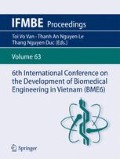Abstract
Grouping frames of a video into groups of pictures (GOP) is an elementary step in video compression to get high compression ratio. In medical field, videos as outputs of some appliances are used for many purposes: for future treatment or for remote diagnosis …, so they must be compressed by using lossless compression methods. This paper proposes a new method to group frames of a video into GOPs based on the theory of ideal cross-point regions. We find the relation between the objects in consecutive frames with the change of the cross-point regions. Experimental results show that the proposed method are effective both for videos which have few or many objects, especially for abrupt change videos.
Access this chapter
Tax calculation will be finalised at checkout
Purchases are for personal use only
Preview
Unable to display preview. Download preview PDF.
References
Sowmyayani S, Arockia Jansi Rani P (2014) Adaptive GOP structure to H.264/AVC based on scene change. ICTACT J image video process spec issue video process multimedia syst 05(01)
Richardson Iain E (2010) The H264 advanced video compression standard. Wiley, USA, pp 287–310
Krulikovska L, Polec J (2012) GOP Structure adaptable to the location of shot cuts. Int J Electron Telecommun 58(2):129–134
Zatt B, Porto M, Scharcanski J, Bampi S (2010) GOP structure adaptive to the video content for efficient H264AVC encoding. In: Proceedings of 17th IEEE International Conference on Image Processing. pp 3053–3056
Sowmyayani S, Arockia Jansi Rani P (2014) Adaptive GOP structure to H.264/AVC based on scene change. ICTACT journal on image and video processing: Special issue on video processing for multimedia systems 05(01)
Yeo BL, Liu B (1995) Rapid scene analysis on compressed video. IEEE transactions on circuits and systems for video technology 5(6)
Sethi IK, Patel N (1995) A statistical approach to scene change detection. SPIE 2420:329–338
Lupatini G, Saraceno C, Leonardi R (1998) Scene break detection: a comparison. In: Proceedings of 8th International Workshop on Continuous-Media Databases and Applications. pp 34–41
Hsu PR, Harashima H (1994) Detecting scene changes and activities in video databases. ICASSP 94 5:33–36
Shahraray B (1995) Scene change detection and content-based sampling of video sequences. Digital video compression Algorithms technol SPIE 2419:2–13
Arman F, Hsu A, Chiu MY (1993) Feature management for large video databases. Storage and retrieval for Image and video databases”, vol SPIE 1908. pp 2–12
Liu HC, Zick GL (1995) Scene decomposition of MPEG compressed video. Digital video compression: algorithms and technologies. SPIE 2419:26–37
Brandt J, Trotzky J, Wolf L (2008) Fast frame-based scene change detection in the compressed domain for MPEG-4 video. In: The Second International Conference on Next Generation Mobile Applications, Services and Technologies
Huang CL, Liao BY (2001) A robust scene change detection method for video segmentation. IEEE transactions on circuits and systems for video technology 11(12)
Le LN, Nguyen NX, Dang TT (2015) A principle of grouping pictures on lossless video compression using ideal cross-point regions. ISEE for science and technology development
Jones CB (1981) Efficient coding system for long source sequences. IEEE Trans Inform Theory 3(27):280–291
Author information
Authors and Affiliations
Corresponding author
Editor information
Editors and Affiliations
Rights and permissions
Copyright information
© 2018 Springer Nature Singapore Pte Ltd.
About this paper
Cite this paper
Le, L.N., Nguyen, S.T., Nguyen, N.X., Dang, T.T. (2018). A Principle of Adaptively Grouping Frames on Lossless Medical Video Compression Using Ideal Cross-Point Regions. In: Vo Van, T., Nguyen Le, T., Nguyen Duc, T. (eds) 6th International Conference on the Development of Biomedical Engineering in Vietnam (BME6) . BME 2017. IFMBE Proceedings, vol 63. Springer, Singapore. https://doi.org/10.1007/978-981-10-4361-1_4
Download citation
DOI: https://doi.org/10.1007/978-981-10-4361-1_4
Published:
Publisher Name: Springer, Singapore
Print ISBN: 978-981-10-4360-4
Online ISBN: 978-981-10-4361-1
eBook Packages: EngineeringEngineering (R0)

